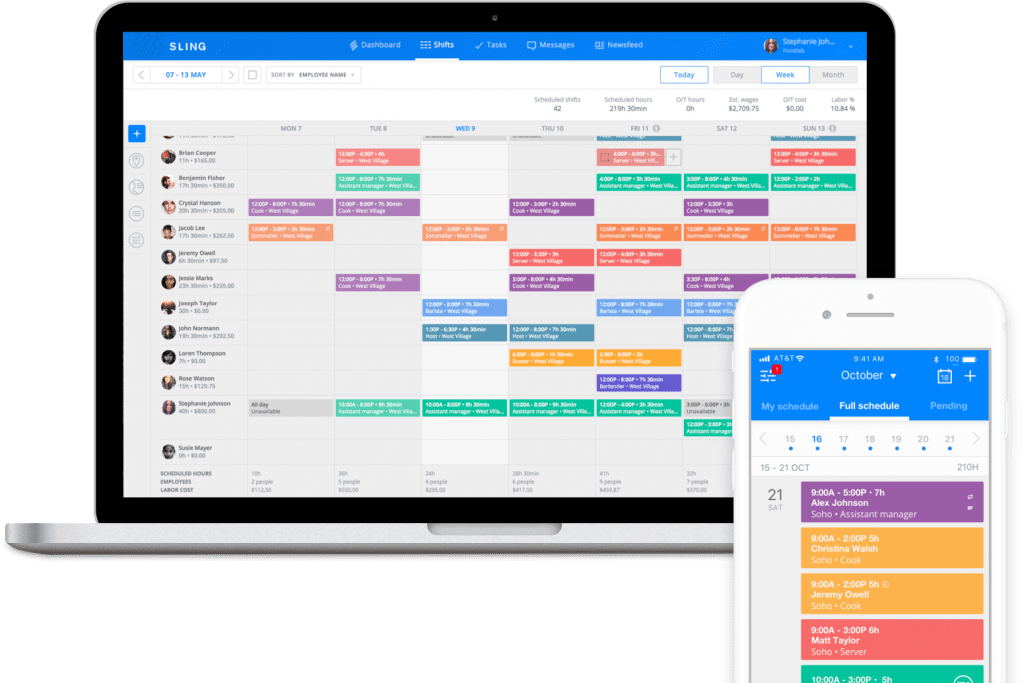How To Create A Weekly Schedule Template
Need to schedule your employees? Don’t reinvent the wheel every time. Let the ...

Need a flexible way to organize the shifts your team works? Self-scheduling may be the answer.
Creating a staff schedule is often one of the most labor-intensive tasks you, as a manager, have to contend with on a regular basis. There are so many moving parts and so many variables that it’s very easy to become overwhelmed.
By setting up a few rules and then allowing your employees to choose when they want to work, you can reduce the effort and stress involved in building a staff rota.
In this article, the workforce management experts tell you everything you need to know about employee self-scheduling, including the benefits, an example of how it works, and the best tool to make it all possible.

Employee self-scheduling, as the name implies, is the practice of letting your team members choose the shifts they want to work — or to trade shifts with others — in order to create the most optimal schedule for themselves and their coworkers.
You, as the manager, still exercise a modicum of control over the process, but self-scheduling frees up your time to focus on other, more pressing responsibilities while your employees basically create the schedule according to what works best for them.

For employees, self-scheduling provides an unprecedented level of flexibility. They can arrange their work time to better fit their personal lives and vice versa.
Flexibility like this makes it easier for your team members to maintain a healthy work/life balance, which translates to happier, healthier, more engaged employees.
No-call, no-show issues happen for a variety of reasons, including:
While it’s impossible to prevent emergencies and inclement weather, self-scheduling goes a long way toward addressing many of the other reasons that team members fail to show up for work.
Employee self-scheduling is also an excellent recruiting and retention tool. When interviewing potential new-hires, you can position the privilege as a benefit that they can’t get anywhere else.
Similarly, the flexibility of self-scheduling and its contribution to work/life balance improves job satisfaction and helps your business retain the top talent it needs to be successful.
Another benefit of employee self-scheduling is that it requires less involvement on the part of the manager or team member responsible for creating the schedule.
There is a bit of work establishing the rules the first time you try self-scheduling. After that, though, the process gets easier: you make the template available and then review the schedule before finalizing and distributing it to your team.

Another benefit of self-scheduling is that you can incorporate it into whatever type of schedule your business uses.
It doesn’t matter if your business runs on a compressed workweek, split shifts, flextime, a 9/80 schedule, night shifts, a combination of these formats, or something else entirely. Self-scheduling integrates easily into a variety of schedules and a variety of industries.
As we mentioned, there will be a bit of work upfront as you formalize the rules for the process, and the first few times through may be a bit bumpy.
But once your employees are familiar with the procedure, this model can actually be enjoyable for both you and your team members.
Here’s a step-by-step example of a self-scheduling process in action.
The first step is to set up guidelines to govern the scheduling process.
These rules can be anything that makes sense for your business, but one common example is that if an employee has a weekend off, they work the Friday before and the Monday after.
Another common rule puts restrictions on the full-time and part-time employees that can work on any given day.
It’s also important to set a start and end date for the self-scheduling so you have time to review what your employees have done and make any necessary changes.
Once you’ve got all your guidelines in place, you create a template that includes the shifts that need to be filled.
Then, two to four weeks or more before you need to finalize the work plan, make the template available for employee self-scheduling.
When the scheduling window is finished, fill in the gaps, correct any errors, make additions or subtractions, and then distribute the final schedule to your team.
In this example, we assume that you’re starting from the very beginning so step one is setting up guidelines for the process.
Once you’ve done that, though, you can skip to step two the next time you need to create a schedule.
Similarly, if you adhere to the same start and end dates every scheduling period (e.g., the 15th of the month to the 30th or 31st of the month), you can go right to step three.
In fact, if you use the same template every time, you just need to make it available and then wait until it’s time to finalize and distribute the finished schedule.

Change is difficult, and your employees may not know what to expect with this new system. But if you maintain a positive attitude about the process, your team will too.
This is also a great opportunity for senior members of your team to support management and lead junior members by displaying a sense of excitement at the upcoming change.
The best way to transition to employee self-scheduling is to meet with your team beforehand to explain the process and address any questions or concerns they may have.
It’s a good idea to have your rules and guidelines written down and ready to go as well as a general idea of when the start and end dates are so your employees have all the details they need.
You may even want to have an example of the template that you can show to everyone and walk them through the act of filling it in.
Then, when it comes time for the first self-scheduling window, they’ll know what to expect and how to get things done.

With the right tools in place to keep everything organized — the rules and guidelines, the process itself, and the final product — employee self-scheduling is one of the easiest ways to optimize your workforce.
The best tool to make all your scheduling easier — not just employee self-scheduling — is the Sling app.
Sling is cloud-based software that makes it easy for everyone involved in the self-scheduling process to access the shared schedule, communicate with each other about who works when, and view changes in real time.
Without Sling, employee self-scheduling would quickly devolve into a communications and organizational nightmare.
In fact, all scheduling is better with the Sling suite of tools.
Whether you build the schedule yourself or let your employees choose their shifts, the Sling app simplifies and streamlines every aspect of the scheduling process — from who works when, where, and in what job to labor expenses, payroll, and overtime.
With Sling’s help, you’ll have more time (and energy) to focus on building your business. Not only is Sling an extremely powerful and versatile scheduling app, but it’s also a:
All of this is rolled into one easy-to-use package that doesn’t take months to get used to. You can even use one Sling account to schedule employees across multiple locations.
Add in the onboard A.I. that notifies you when there’s a scheduling conflict or you missed a request for time off, and you’ve got the perfect system for managing your team.
The Sling app is free, easy to use, and will help your team self-schedule themselves so you can concentrate on building the intangible aspects of your team — like company culture, your management style, and your business as a whole.
For more free resources to help you manage your business better, organize and schedule your team, and track and calculate labor costs, visit GetSling.com today.
See Here For Last Updated Dates: Link
This content is for informational purposes and is not intended as legal, tax, HR, or any other professional advice. Please contact an attorney or other professional for specific advice.
Schedule faster, communicate better, get things done.